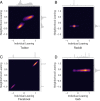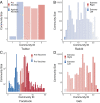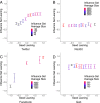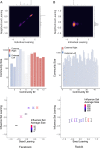The echo chamber effect on social media - PubMed (original) (raw)
The echo chamber effect on social media
Matteo Cinelli et al. Proc Natl Acad Sci U S A. 2021.
Abstract
Social media may limit the exposure to diverse perspectives and favor the formation of groups of like-minded users framing and reinforcing a shared narrative, that is, echo chambers. However, the interaction paradigms among users and feed algorithms greatly vary across social media platforms. This paper explores the key differences between the main social media platforms and how they are likely to influence information spreading and echo chambers' formation. We perform a comparative analysis of more than 100 million pieces of content concerning several controversial topics (e.g., gun control, vaccination, abortion) from Gab, Facebook, Reddit, and Twitter. We quantify echo chambers over social media by two main ingredients: 1) homophily in the interaction networks and 2) bias in the information diffusion toward like-minded peers. Our results show that the aggregation of users in homophilic clusters dominate online interactions on Facebook and Twitter. We conclude the paper by directly comparing news consumption on Facebook and Reddit, finding higher segregation on Facebook.
Keywords: echo chambers; information spreading; polarization; social media.
Copyright © 2021 the Author(s). Published by PNAS.
Conflict of interest statement
The authors declare no competing interest.
Figures
Fig. 1.
Joint distribution of the leaning of users x and the average leaning of their neighborhood xNN for different datasets. (A) Twitter, (B) Reddit, (C) Facebook, and (D) Gab. Colors represent the density of users: The lighter the color, the larger the number of users. Marginal distribution P(x) and PN(x) are plotted on the x and y axes, respectively. Facebook and Twitter present by homophilic clustering.
Fig. 2.
Size and average leaning of communities detected in different datasets. A and C show the full spectrum of leanings related to the topics of abortions and vaccines with regard to communities in B and D, where the political leaning is less sparse.
Fig. 3.
Average leaning ⟨μ(x)⟩ of the influence sets reached by users with leaning x, for different datasets under consideration. Size and color of each point represent the average size of the influence sets. The parameters of the SIR dynamics are set to (A) β=0.10⟨k⟩−1, (B) β=0.01⟨k⟩−1, (C) β=0.05⟨k⟩−1, and (D) β=0.05⟨k⟩−1, while ν is fixed at 0.2 for all simulations.
Fig. 4.
Direct comparison of news consumption on (A) Facebook and (B) Reddit. Joint distribution of the leaning of users x and the average leaning of their nearest neighbor xN (Top), size and average leaning of communities detected in the interaction networks (Middle), and average leaning ⟨μ(x)⟩ of the influence sets reached by users with leaning x, by running SIR dynamics (Bottom) with parameters β=0.05⟨k⟩ for A, β=0.006⟨k⟩ for B, and ν=0.2 for both. Facebook presents a highly segregated structure with regard to Reddit.
Similar articles
- Trend of Narratives in the Age of Misinformation.
Bessi A, Zollo F, Del Vicario M, Scala A, Caldarelli G, Quattrociocchi W. Bessi A, et al. PLoS One. 2015 Aug 14;10(8):e0134641. doi: 10.1371/journal.pone.0134641. eCollection 2015. PLoS One. 2015. PMID: 26275043 Free PMC article. - Polarization of the vaccination debate on Facebook.
Schmidt AL, Zollo F, Scala A, Betsch C, Quattrociocchi W. Schmidt AL, et al. Vaccine. 2018 Jun 14;36(25):3606-3612. doi: 10.1016/j.vaccine.2018.05.040. Vaccine. 2018. PMID: 29773322 - Opinion Leaders and Structural Hole Spanners Influencing Echo Chambers in Discussions About COVID-19 Vaccines on Social Media in China: Network Analysis.
Wang D, Zhou Y, Ma F. Wang D, et al. J Med Internet Res. 2022 Nov 18;24(11):e40701. doi: 10.2196/40701. J Med Internet Res. 2022. PMID: 36367965 Free PMC article. - Conspiracy theories and social media platforms.
Cinelli M, Etta G, Avalle M, Quattrociocchi A, Di Marco N, Valensise C, Galeazzi A, Quattrociocchi W. Cinelli M, et al. Curr Opin Psychol. 2022 Oct;47:101407. doi: 10.1016/j.copsyc.2022.101407. Epub 2022 Jun 30. Curr Opin Psychol. 2022. PMID: 35868169 Review. - Dynamics of macroscopic diffusion across meta-populations with top-down and bottom-up approaches: A review.
Kim M, Kim S. Kim M, et al. Math Biosci Eng. 2022 Mar 7;19(5):4610-4626. doi: 10.3934/mbe.2022213. Math Biosci Eng. 2022. PMID: 35430830 Review.
Cited by
- TikTok content on measles-rubella vaccine in Jordan: A cross-sectional study highlighting the spread of vaccine misinformation.
Abdaljaleel M, Barakat M, Mahafzah A, Hallit R, Hallit S, Sallam M. Abdaljaleel M, et al. Narra J. 2024 Aug;4(2):e877. doi: 10.52225/narra.v4i2.877. Epub 2024 Jul 26. Narra J. 2024. PMID: 39280304 Free PMC article. - YouTube's recommendation algorithm is left-leaning in the United States.
Ibrahim H, AlDahoul N, Lee S, Rahwan T, Zaki Y. Ibrahim H, et al. PNAS Nexus. 2023 Aug 14;2(8):pgad264. doi: 10.1093/pnasnexus/pgad264. eCollection 2023 Aug. PNAS Nexus. 2023. PMID: 37601308 Free PMC article. - Robustness of privacy-preserving collaborative recommenders against popularity bias problem.
Gulsoy M, Yalcin E, Bilge A. Gulsoy M, et al. PeerJ Comput Sci. 2023 Jul 6;9:e1438. doi: 10.7717/peerj-cs.1438. eCollection 2023. PeerJ Comput Sci. 2023. PMID: 37547423 Free PMC article. - The COVID-19 pandemic and the search for structure: Social media and conspiracy theories.
Dow BJ, Johnson AL, Wang CS, Whitson J, Menon T. Dow BJ, et al. Soc Personal Psychol Compass. 2021 Sep;15(9):e12636. doi: 10.1111/spc3.12636. Epub 2021 Aug 4. Soc Personal Psychol Compass. 2021. PMID: 34512798 Free PMC article. - Characterizing engagement dynamics across topics on Facebook.
Etta G, Sangiorgio E, Di Marco N, Avalle M, Scala A, Cinelli M, Quattrociocchi W. Etta G, et al. PLoS One. 2023 Jun 28;18(6):e0286150. doi: 10.1371/journal.pone.0286150. eCollection 2023. PLoS One. 2023. PMID: 37379268 Free PMC article.
References
- Dubois E., Blank G., The echo chamber is overstated: The moderating effect of political interest and diverse media. Inf. Commun. Soc. 21, 729–745 (2018).
- Bode L., Political news in the news feed: Learning politics from social media. Mass Commun. Soc. 19, 24–48 (2016).
- Newman N., Fletcher R., Kalogeropoulos A., Nielsen R., “Reuters Institute Digital News Report 2019” (Rep. 2019, Reuters Institute for the Study of Journalism, 2019).
- Flaxman S., Goel S., Rao J. M., Filter bubbles, echo chambers, and online news consumption. Publ. Opin. Q. 80, 298–320 (2016).
MeSH terms
LinkOut - more resources
Full Text Sources
Other Literature Sources



